Masonry
![]()
The title of this article is ambiguous. For the German rower, see Mark Mauerwerk.
Masonry is a building component made of masonry blocks joined together as a solid construction. Masonry construction is distinguished from other construction techniques, such as timber construction, reinforced concrete construction or steel construction, by specific techniques and materials.
Masonry consists of individual compression-resistant elements (natural stones or artificial stones such as clay bricks, masonry bricks or hollow blocks), which are joined together with or without mortar in a masonry bond. If the flat structure made of masonry is a wall, it is called a masonry wall. However, other components such as the inner pipes of free-standing chimneys can also be made of masonry in accordance with DIN EN 13084-4.
Structural elements that consist only of reinforced concrete are by definition not masonry. A masonry structure is built from individual bricks, whereas monolithic components are cast from concrete. Nevertheless, masonry construction is also used within reinforced concrete construction, in that it is used - possibly in combination with timber construction - to close the gaps in the load-bearing structure, to reinforce it or to face it. Masonry, depending on the masonry block used, can absorb high compressive forces but only low tensile forces. In this respect it is therefore very similar to concrete. This has resulted in the practice of increasing tensile strength by inserting reinforcing steel. Reinforced masonry is the combination of conventional, traditional masonry with vertically or horizontally inserted reinforcement.
Walls are walls that are built from masonry. With the same dimensions, they do not achieve as high a strength and load-bearing effect as concrete or reinforced concrete walls. Since the construction of concrete walls from in-situ concrete usually takes more time due to the necessary formwork and curing, non-load-bearing walls made of masonry are often preferred as a faster and more cost-effective alternative by executing companies and building owners. A masonry bond is understood to be the laying of masonry units according to fixed rules of the joining technique, always taking into account staggered butt joints. The craftsman trained and active in masonry construction is called a bricklayer.
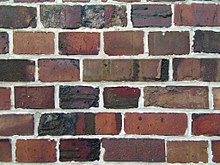
clinker masonry
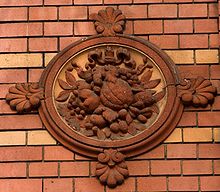
Fine facing brickwork made of clinker bricks with terracotta medallion
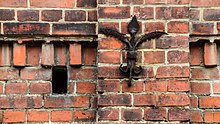
Exposed brickwork with decorative elements and brick stamps
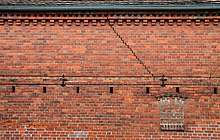
Exposed brickwork with decorative elements
Classification
The types of masonry are named after different aspects:
- according to the stones used: Quarry stone masonry, natural stone masonry, brick masonry and other natural and man-made stones.
- according to the type of material for jointing: Dry masonry, mortar masonry, homogeneous and inhomogeneous masonry.
- according to visibility: exposed masonry, facing masonry
- according to the static function: load-bearing or non-load-bearing brickwork
Masonry consists of individual bricks that are stacked on top of each other. Different types of stones are used:
- artificial stones:
- Clay brick
- Bricks (masonry bricks)
- Concrete blocks
- Expanded clay bricks
- Hollow blocks
- Perforated brick
- Sand-lime bricks
- Clinker
- Aerated concrete blocks.
- Alluvial
In order to simplify the use of artificial masonry units, their stone format is regulated by standards.
- Natural stones:
- Sedimentary rocks like limestone or sandstone
- Deep rocks like granite
In addition, for certain types of masonry, there is also mortar, which can fill the joints between the bricks. This connects the bricks friction-locked and ensures better stability of the masonry. Chamfer stones visually emphasize the joint.
To compensate for the height, kimm bricks are installed.
The wedge-shaped bricks used for masonry of arches, vaults and other curves are called wedge bricks, wedge bricks or arch bricks.

Quarry stone masonry
.jpg)
Quarry stone wall unplastered, in the Erzgebirge, (Fürstenau)
According to stones used
Natural rock
Natural stone masonry
→ Main article: Natural stone masonry
Natural stone masonry is a generic term for masonry consisting of natural stones and mortar, e.g. sedimentary rocks such as limestone or sandstone, igneous rocks such as granite and rhyolite, or metamorphic rocks such as marble and gneiss. Fieldstone also counts as natural stone masonry, and is often read stone.
Quarry stone wall
Quarry stone masonry is the term used to describe natural stone masonry made of quarry stones - often locally occurring natural stones - stacked in a bond and with mortar. The quarry stones are only roughly worked or hewn until they have two more or less parallel sides. They are then built up with mortar, which, according to the now withdrawn DIN 1053-1, makes it a mixed masonry. This procedure is a very simple way to build a wall. In contrast to course masonry, one does not need to produce artificial stones oneself, but uses locally occurring quarry stone. A special form of quarry stone masonry is cyclopean masonry. For the Staufer period, the humped ashlar or ashlar masonry was typical.
In order to stabilize such walls - especially on slopes - especially long, large stones are set at regular intervals, which reach from the front through the entire wall to the slope on the other side; these stones are called binders or binding stones. Sometimes they can even protrude from the front of the wall and serve as steps to climb over the wall.
In South Jordan, cellar masonry made of natural stones was found in the present-day town of Basta, which were walled up with lime mortar and dated to about 6000 BC. In the area of the Osterzgebirge, walls were later plastered with "Zinnwälder Sand" (and cement), which had a very high strength. Today, quarry stone masonry is rarely used, mainly in gardening and landscaping, as garden walls or in vineyards.
Example: quarry stone wall Hauptstraße 133 (Lendersdorf)
Cyclopean Masonry
→ Main article: Cyclopean masonry
Cyclopean masonry is a special form of quarry masonry made of very large, irregular stones that are carefully stacked on top of each other. If the material is in stock and the exposed face of the masonry units is more or less rectangular, it is referred to as quarry masonry. If the visible surface is irregular and polygonal, it is called cyclopean masonry. The joint pattern is irregular and without horizontal bearing joints. Often it is a wall built in shell construction with an inner filling of stones and clay.
(Limestone) sandstone masonry
Masonry consisting of sandstones or sand-lime bricks and mortar. Mostly used as load-bearing masonry. Sand-lime bricks can be used for slender partition walls because of their high gross density class and high stone compressive strength class, and thus good sound insulation combined with high load-bearing capacity.
Fieldstone masonry
Fieldstone buildings are constructed using the two-shell technique, a very early technique. There is an inner and an outer wall, which were laid with mortar. In the very rare examples of dry stone masonry (chapels in Ireland) there is no two-shell technique. In the older buildings the outer shell is made of larger fieldstones and the inner shell of smaller fieldstones or natural stone ashlars. The space between these walls, about a metre or more thick, was filled with mortar, unhewn fieldstones and rubble from stone dressing. In many medieval churches, the outer shell of the wall is exposed stone, while the inner was usually plastered. An experienced medieval master builder usually built optimally according to empirically obtained rules. The biggest problems were probably caused by different settlements of the building ground, because the tower area had a greater weight due to its greater mass and therefore caused a higher ground pressure. This resulted in settlement cracks between the tower and the nave, which can often be observed in fieldstone village churches.
Artificial stones
Clinker masonry
Masonry consisting of clinker and mortar. See also article Masonry bond.
Brick masonry
Consists of bricks and mortar, nowadays mostly used as back-up masonry (i.e. load-bearing wall) or facing masonry. See also article Masonry bond.
Expanded clay masonry
Masonry blocks made of clay and cement, used as load-bearing wall. The expanded clay beads are granulated from 150 million year old Lias clay. All biological components burn and thus create small air pockets. The beads with different dimensions are mixed with aggregates (sand, water, cement, etc.) and pressed and must then set for several days. Firing of the stones is not necessary.
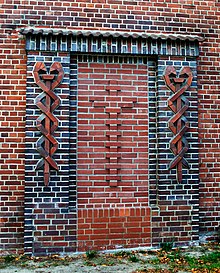
Asclepius staff and cross
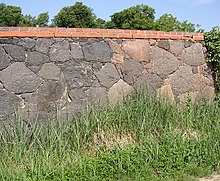
Fieldstone wall in Wriezen-Haselberg

Cyclopean masonry in Stockholm
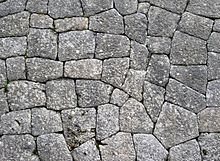
Cyclopean masonry in Mallorca

Quarry stone masonry
Search within the encyclopedia